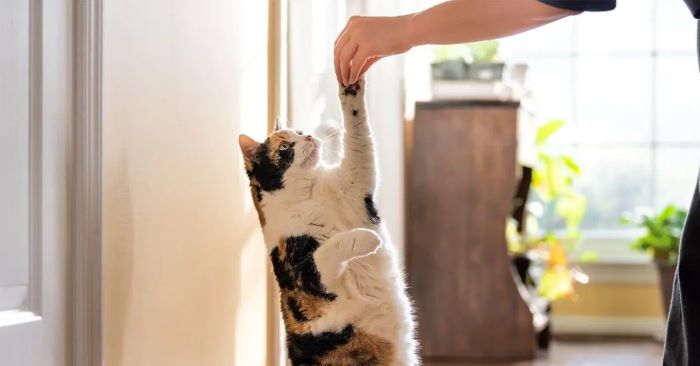Proper training is definitely the key to a happy owner-pet relationship. It establishes your dominance in the relationship between you and your cat right from the start, and it can help prevent many behavioral challenges from rearing their ugly heads later on.
Solid training can also keep your cat out of troublesome situations that could threaten both its health and yours.
There is one characteristic exhibited by every good trainer: patience. Without this virtue, you’re going to have a tough time teaching your cat anything. You need to set aside time each day for training and resolve to stick to it.
Keep in mind that it will only be a temporary dip into your time budget. After all, the more time you devote from the start, the quicker and more satisfying the results will be.
What about training school? Is it worth the time and the money? The answer is “Yes” if it will motivate you to devote the time for the task at hand. You still have to be physically present during the training.
If you choose this route, enroll in an active-participation class in which an instructor directs you and your cat through the training session. However, keep in mind that such a class doesn’t relieve you of your homework duties. You still need to practice with your kitten daily on your home turf.
Main Principles of Training
For any training method to be effective, it must follow some basic principles to ensure its success. Some of these principles are described in the following paragraphs.
Consistency and Repetition
The magic success formula for all training endeavors is derived from two key concepts: consistency and repetition. Consistency provides the building blocks; repetition is the mortar that holds the program together. Without the two, you might as well try to teach a rock how to fetch. The results will be the same!
Consistency means more than just using the same commands over and over again. It also means using the same praises and corrections each time and keeping your voice tones consistently unique for each.
Even your body language and postures used during training should remain uniform between sessions. As trivial as it might seem, cats pick up on stuff like that. Cats also like routine, so stick to it. Train at the same hour each day and for the same length of time for each daily session.
Just as important as consistency to a cat’s learning process is repetition. Repeating an action or training drill over and over will help reinforce the positive response you are looking for. Furthermore, the more repetition you implement into training, the leaner and more refined your pet’s learned skills become.
Verbal Praise
Use verbal praise instead of physical pain in your training sessions. Food treats are fine as a reward supplement, but they should never replace verbal compliments. Punishment might be warranted if your pet purposely disobeys a command or commits an undesirable act, but this should never take the form of physical punishment.
There are alternative means, each of which is at least just as effective as physical violence.
Punishment

Cats can be reprimanded effectively with a sharp verbal “No.” Water sprayers, air horns, a can full of coins, handheld vacuums, and so on can all be used to gain your pet’s attention quickly without inflicting any pain. If you decide to use punishment, be sure to institute it quickly, preferably within 5 seconds of the act.
If you don’t apply it before this time expires, any punishment thereafter might satisfy your anger, but it will serve no useful training purpose. Don’t extend your punishment past a few seconds. Prolonged exhortations will only confuse your pet (and might cause you to lose your voice).
Never use your pet’s name during the negative reinforcement. If you do, your pet might start to associate its name with the bad act and eventually become a basket case whenever the name is called. Reserve this name calling for positive, happy experiences only.
If you do punish, always follow it up shortly thereafter with a command or drill that will lead to a praise situation. Remember that the most effective training programs rely on praise more than on punishment.
Other Suggestions
- Get the whole family involved. In any training situation, always try to involve all members of the family. An all-too-common scenario is one in which a pet virtually ignores the commands of anyone but the one person who trained it.To avoid this, get the whole family involved. Just be sure to remain consistent within the family with regard to the training methods and commands used.
- Use short commands. All verbal commands you employ need to be kept short and sweet. Using slightly different voice tones for each command will help prevent confusion. If verbal punishment is to be used, make certain that it is totally different in tone and in presentation than the other commands.
- Start young. Always start your pet’s training at an early age. While it is true that certain advanced training techniques can be best taught at around 6 months of age, basic training, should be started as early as 8 weeks of age. If basic command training is not taught this early in life, bad habits arise later on, some of which can put a damper on future training efforts.
- Keep training sessions short. Try to keep the training sessions short and to the point. For kittens 8 to 12 weeks of age, devoting 10 minutes two to three times daily will yield excellent results.As your pet matures, the length of each of these sessions can increase. Let your pet’s attitude be your judge. If it seems bored or indifferent, or has become totally unruly, you have probably exceeded its attention span.
- End on a good note. Always end your training session on a good note. Doing so is very constructive in terms of your pet’s mental development, and effectively sets the tone for the next session.


